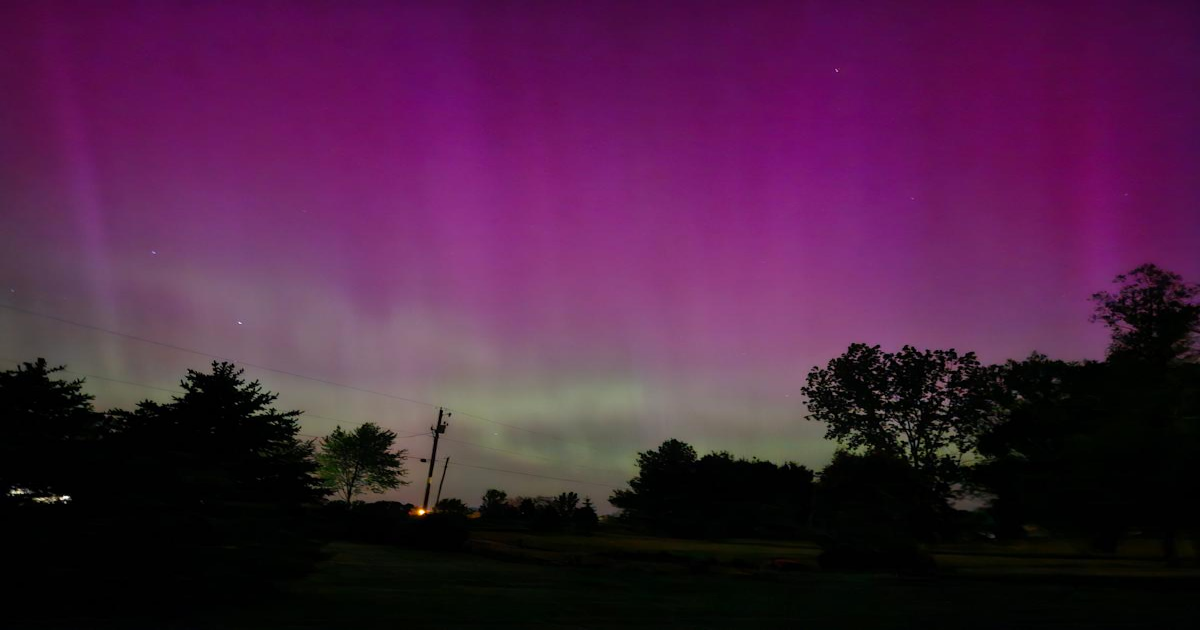The northern lights may shine in the skies over Ohio this week as a pair of solar storms target the Earth.
The aurora borealis has already put on several shows in the Buckeye State, glowing overhead in May 2024 and returning for an encore that October. There was even a chance for a surprise appearance on New Year’s Eve.
Here’s what to know about the northern lights in Ohio this week.
The sky in 2025: Every eclipse, comet, meteor shower to see in Ohio
Pair of solar eruptions target Earth, may bring the aurora borealis to Ohio on Wednesday
According to the Space Weather Prediction Center, a pair of solar eruptions called coronal mass ejections are targeting the Earth and are expected to hit on Wednesday. The center has issued a moderate geomagnetic storm watch (level 2 out of 5) for April 16.
If the solar storm hits at that intensity, it could push the aurora into the northernmost states and as far south as Lake Erie, possibly making them visible from Northern Ohio. If it grows stronger, the aurora might be pushed farther south and across more portions of Ohio.
Aurora borealis map
This map from the Space Weather Prediction Center shows where the northern lights could be visible on April 16. The red line over Lake Erie shows how far south the aurora may stretch, which could bring the lights into Ohio.
This map from the Space Weather Prediction Center shows how far south the northern lights might come during the solar storm that could hit Earth on April 16.
What is the aurora borealis? What causes the northern lights?
Auroras are ribbons of light weaving across Earth’s northern or southern polar regions, according to NASA. They are caused by magnetic storms that have been triggered by solar activity, such as solar flares or coronal mass ejections. The solar wind carries energetic charged particles from these events away from the Sun and toward the Earth.
These energized particles hit the atmosphere at 45 million mph and are redirected to the poles by the earth’s magnetic field, according to Space.com, creating the light show.
During major geomagnetic storms, the lights expand away from the poles and can be seen over some parts of the United States, according to the NOAA.
What causes the northern lights? About the aurora borealis and why it’s visible over Ohio
What is a coronal mass ejection?
NASA describes coronal mass ejections as “huge bubbles of coronal plasma threaded by intense magnetic field lines that are ejected from the Sun over several hours.” The Akron Beacon Journal reports that the space agency says they often look like “huge, twisted ropes” and can occur with solar flares, or explosions on the sun’s surface.
How to view the aurora borealis in Ohio
During times of high geomagnetic activity, which pushes the northern lights further south, the aurora will be visible directly overhead in the northern United States, according to the prediction center.
For the best viewing, the center recommends that it be very dark. Get away from city lights and avoid trying to see them on the night of a full moon. The best time to view the aurora is within an hour or two of midnight, or 10 p.m. to 2 a.m.
Will the northern lights come to Ohio again in 2025?
While there’s no guarantee where the northern lights will be seen this year, the potential is there for more visits to Ohio. The sun has entered its solar maximum, NASA and the NOAA announced in October, meaning it is at its most active for sunspots that generate those solar storms. The sun will be at its maximum for a year, NASA reports, after which solar storms will decrease and take the aurora with them.
However, the northern lights are fickle. It’s never 100% certain they’ll show up in Ohio until they appear over your head.
Still, the aurora borealis can be forecast with a certain degree of accuracy. And that’s the job of the Space Weather Prediction Center. The center monitors sunspots, solar flares and plasma emissions called coronal mass ejections that could impact the electrical grid, communication, satellites and more. It also announces when these solar storms could energize the aurora, pushing it out of its arctic home and into the United States. Due to the travel time of these storms from the sun to the Earth, the center’s forecasts come with a day or two of advance notice.
This article originally appeared on Akron Beacon Journal: Will Ohio see the northern lights tonight? See the map, forecast
